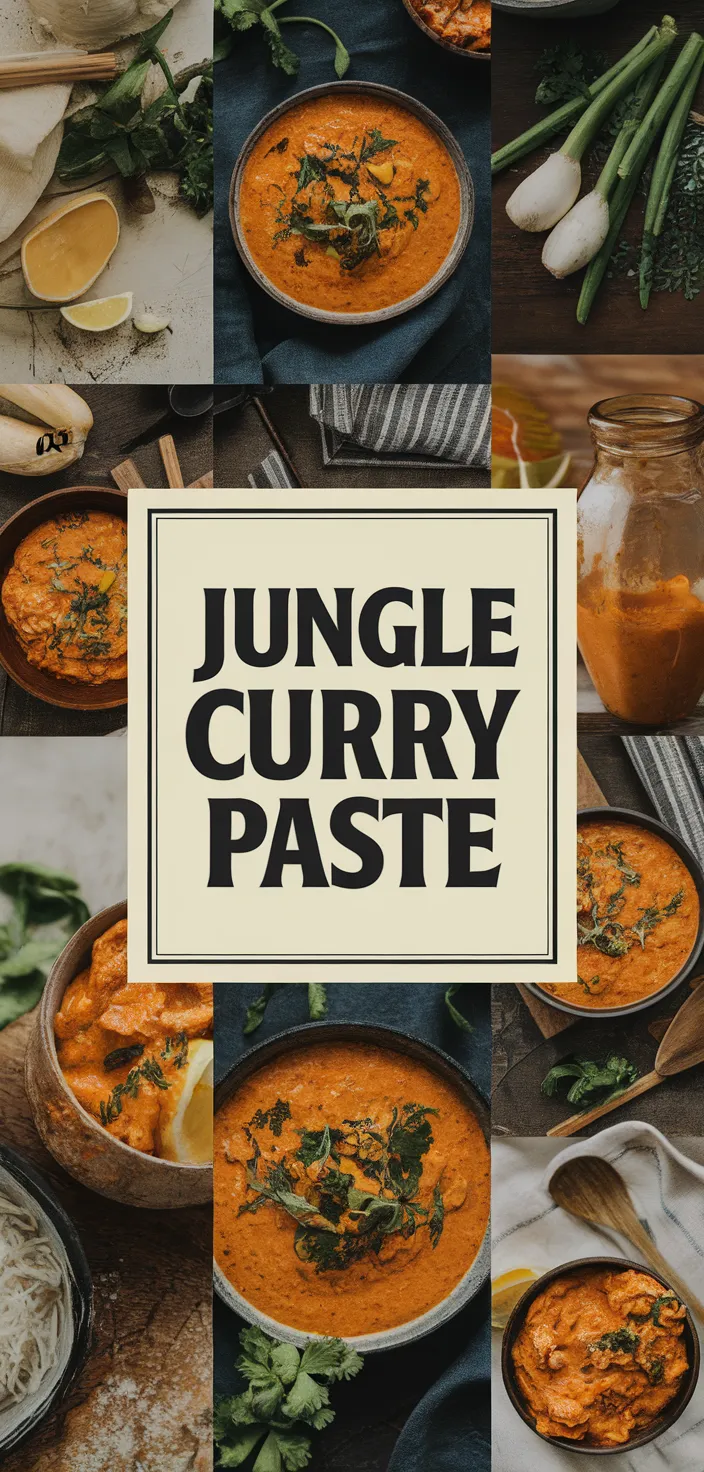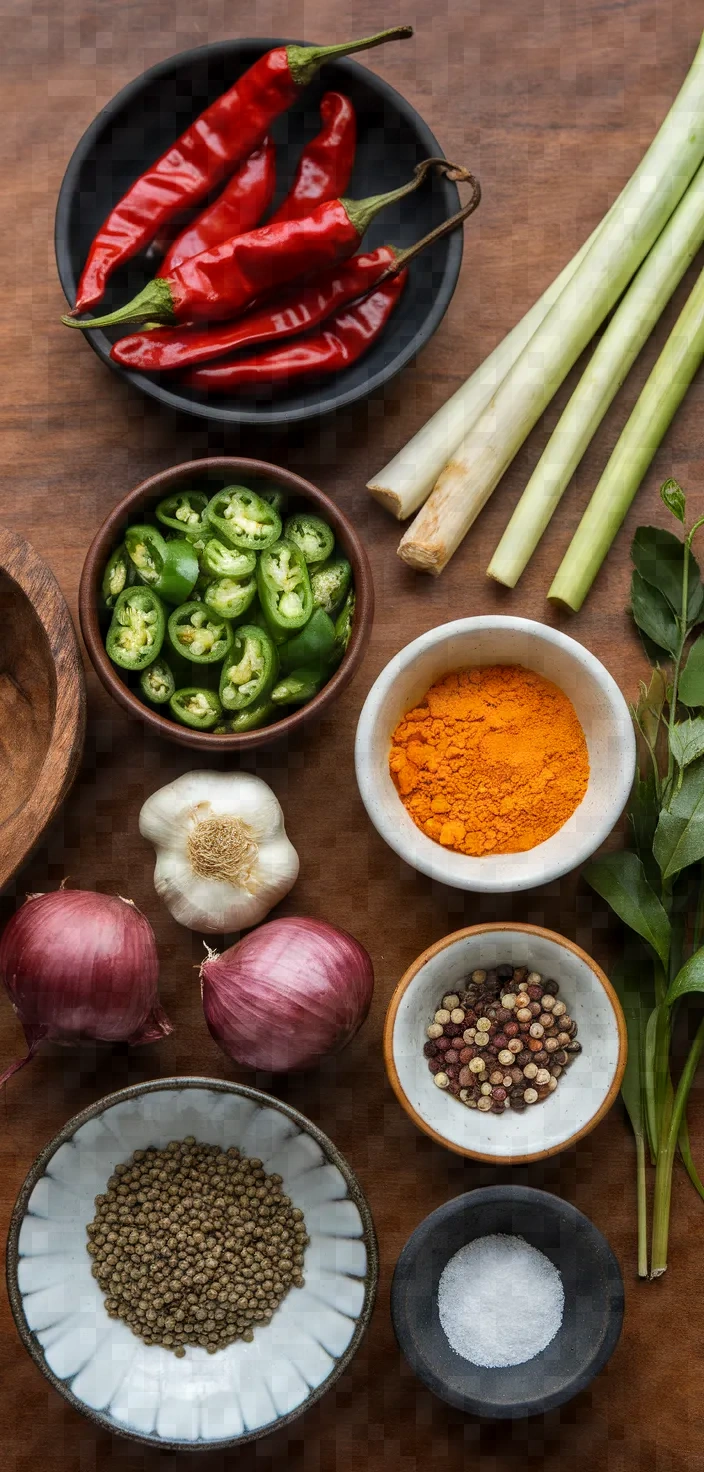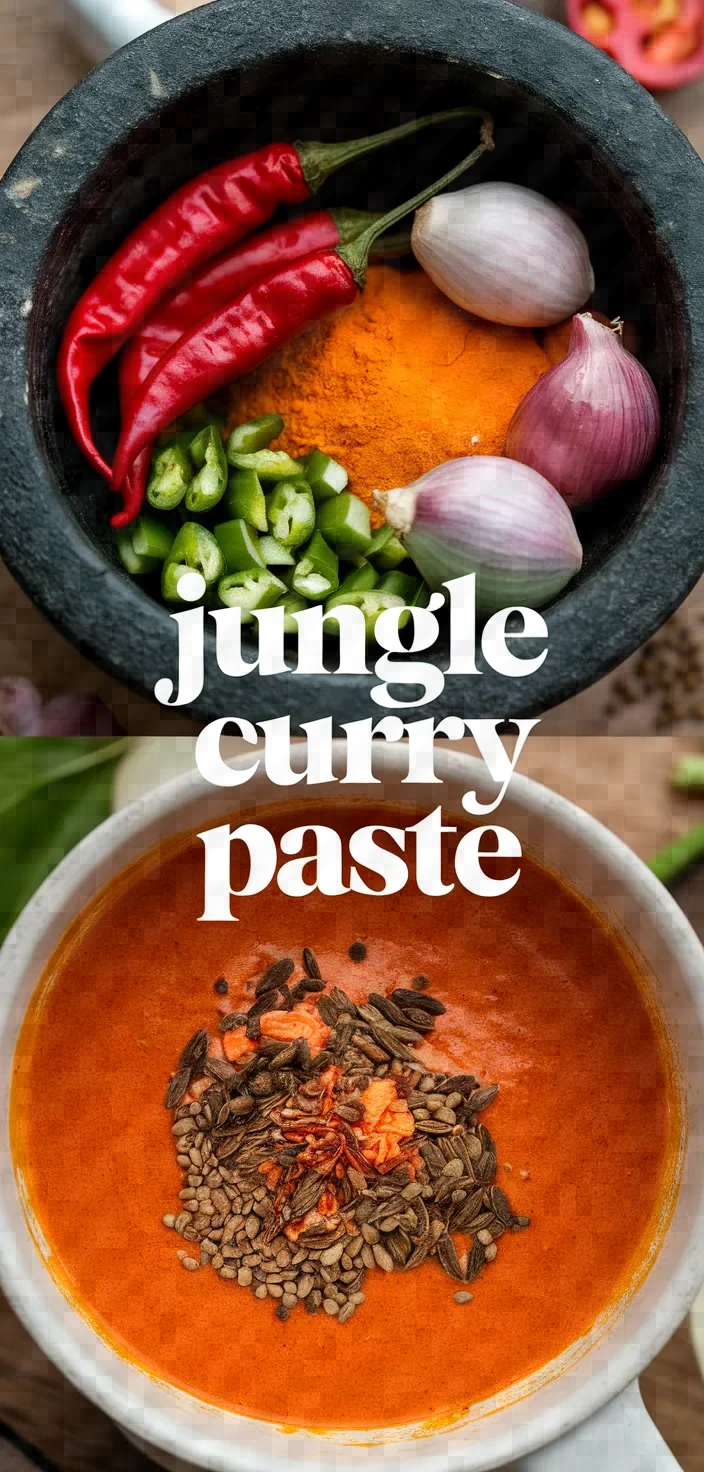I absolutely love this recipe because it combines an amazing blend of vibrant flavors that truly transform any dish into a culinary adventure. Plus, it’s a perfect excuse to indulge my millennial obsession with homemade, exotic, and spicy foods that feel both artisanal and authentic.

I love the creation of strong, vibrant recipes, and jungle curry paste is one of my favorites. With a fiery combination of dried red chilies and fresh green ones, it really packs a punch.
The smell of galangal, the fresh turmeric and lemongrass, are simply divine, and the addition of shrimp paste and lime zest really rounds out the flavor profile.
Ingredients

Dried Red Chilies:
Impart warmth and profundity.
Abundant in vitamins A and C.
Fresh Green Chilies:
Contributes new, lively flavor.
High in antioxidants.
Galangal:
Conveys a tangy, zesty taste.
Helps with digestion and curbs inflammation.
Turmeric:
Rich flavor, vivid hue.
Famous for its anti-inflammatory effects.
Lemongrass:
Smelling salt; serves to strengthen the digestive system, patently rich in antioxidants.
Garlic:
Strong, satisfying taste.
Enhances body’s defenses; has germ-fighting qualities.
Shallots:
Mildly sweet onions have a mild taste.
They give fiber, antioxidants, and other beneficial substances, such as quercetin (a potent antioxidant), and many helpful phytochemicals.
Ingredient Quantities
- 10 dried red chilies, seeds removed and soaked in warm water
- 5 fresh green chilies, chopped
- 1 tbsp galangal, chopped
- 1 tbsp fresh turmeric, chopped
- 2 stalks lemongrass, thinly sliced
- 5 cloves garlic, peeled
- 5 shallots, peeled and chopped
- 1 tsp lime zest
- 1 tbsp shrimp paste
- 2 tsp coriander seeds, toasted
- 1 tsp cumin seeds, toasted
- 1 tsp black peppercorns
- 1 tsp salt
Instructions
1. Soaked dried red chilies should be drained and then placed in a mortar and pestle or food processor.
2. Incorporate freshly chopped green chilies, chopped galangal, chopped turmeric, and thinly sliced lemongrass.
3. Place the garlic cloves, which have been peeled, and the chopped shallots into the mixture.
4. The lime zest should be grated and added to the mixture.
5. Incorporate the shrimp paste into the mixture of ingredients.
6. In a dry pan over medium heat, toast the coriander seeds and cumin seeds until they are fragrant, and then add them to the mixture.
7. Put in the black peppercorns and salt.
8. All the ingredients should be pounded or blended together until they form a smooth paste, scraping the sides of the container as necessary.
9. Sample the paste and modify the flavoring as required.
10. An airtight container is the ideal home for the paste, whether it’s in the fridge or the freezer. In the fridge, it can last up to a fortnight, but if you want to keep it for longer, the freezer is your friend.
Equipment Needed
1. Mortar and pestle or food processor
2. Knife
3. Cutting board
4. Grater (for lime zest)
5. Dry pan (for toasting spices)
6. Airtight container (for storing the paste)
7. Spoon (for mixing and measuring ingredients)
FAQ
- Q: Can I use fresh red chilies instead of dried ones?A: For this paste, using dried chilies is traditional and gives a deeper flavor, but you can also use fresh ones if you need to. The paste will taste and look different, though.
- Q: How long can I store the Jungle Curry Paste?Refrigerate the paste in an airtight container for up to two weeks. Otherwise, freeze it in portions for longer storage.
- Q: What can I substitute for shrimp paste?If you’re hoping to find a vegetarian alternative, try using miso paste. For those who eat fish, adding fish sauce or anchovy paste will give a similar umami flavor.
- Q: Can I omit the fresh turmeric if I can’t find it?If you can’t find fresh turmeric, you’re not out of luck. You can use 1 teaspoon of ground turmeric as a stand-in.
- Q: Is it necessary to toast the coriander and cumin seeds?To enhance their aroma and flavor, it’s best to toast seeds before using them, but you can use pre-ground spices in a pinch.
- Q: Can I adjust the spiciness level of the paste?Yes, you can exert some influence over the spiciness factor of the paste by decreasing the amount of fresh and dried chiles used or by removing some seeds (which can contain a lot of heat) for a milder version.
- Q: What equipment do I need to make this curry paste?A food processor will save time and effort if you have it available, but a mortar and pestle are traditional tools for the job.
Substitutions and Variations
Dried cayenne peppers, seeds removed and soaked in warm water: If you are seeking a substitute that offers a comparable temperature, these will do the trick.
Chopped fresh green chilies: Use serrano peppers for a similar flavor and heat.
Chopped galangal: If you can’t find this ingredient, use fresh ginger in an equal amount; however, this will slightly change the flavor.
Turmeric, fresh and chopped: If unavailable, substitute with 1 tsp of ground turmeric.
Shrimp paste: Fish sauce can be used as a substitute, but it is best to start with half the amount and adjust to taste because fish sauce is quite salty. Both fish sauce and shrimp paste pack a similar umami punch and will provide the same flavor depth to Thai recipes.
Pro Tips
1. Galangal and Turmeric Texture: Ensure the galangal and turmeric are finely chopped before adding them to the food processor or mortar and pestle. This will help achieve a smoother paste and make blending easier.
2. Lemongrass Preparation: Only use the tender inner part of the lemongrass stalks. The outer layers can be too fibrous and difficult to blend. Thin slices will integrate into the paste more effectively.
3. Spice Toasting: Toast the coriander and cumin seeds separately for the best flavor release. Shake the pan gently and continuously to prevent burning, and wait until the spices are lightly browned and aromatic before removing them.
4. Shrimp Paste Activation: For a deeper umami flavor, consider lightly toasting the shrimp paste by wrapping it in foil and placing it in a hot pan or oven for a few minutes before adding it to the mixture.
5. Flavor Adjustments: If you find the paste too spicy or strong, balance it by adding a small amount of sugar or an additional pinch of salt. Always taste and adjust incrementally to avoid overpowering the other flavors.

Jungle Curry Paste Recipe
My favorite Jungle Curry Paste Recipe
Equipment Needed:
1. Mortar and pestle or food processor
2. Knife
3. Cutting board
4. Grater (for lime zest)
5. Dry pan (for toasting spices)
6. Airtight container (for storing the paste)
7. Spoon (for mixing and measuring ingredients)
Ingredients:
- 10 dried red chilies, seeds removed and soaked in warm water
- 5 fresh green chilies, chopped
- 1 tbsp galangal, chopped
- 1 tbsp fresh turmeric, chopped
- 2 stalks lemongrass, thinly sliced
- 5 cloves garlic, peeled
- 5 shallots, peeled and chopped
- 1 tsp lime zest
- 1 tbsp shrimp paste
- 2 tsp coriander seeds, toasted
- 1 tsp cumin seeds, toasted
- 1 tsp black peppercorns
- 1 tsp salt
Instructions:
1. Soaked dried red chilies should be drained and then placed in a mortar and pestle or food processor.
2. Incorporate freshly chopped green chilies, chopped galangal, chopped turmeric, and thinly sliced lemongrass.
3. Place the garlic cloves, which have been peeled, and the chopped shallots into the mixture.
4. The lime zest should be grated and added to the mixture.
5. Incorporate the shrimp paste into the mixture of ingredients.
6. In a dry pan over medium heat, toast the coriander seeds and cumin seeds until they are fragrant, and then add them to the mixture.
7. Put in the black peppercorns and salt.
8. All the ingredients should be pounded or blended together until they form a smooth paste, scraping the sides of the container as necessary.
9. Sample the paste and modify the flavoring as required.
10. An airtight container is the ideal home for the paste, whether it’s in the fridge or the freezer. In the fridge, it can last up to a fortnight, but if you want to keep it for longer, the freezer is your friend.
